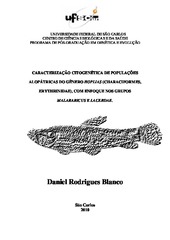Caracterização citogenética de populações alopátricas do gênero Hoplias (Characiformes, Erythrinidae), com enfoque nos grupos malabaricus e lacerdae
Abstract
Erythrinidae represents a relatively small family of Neotropical fish, presenting a great geographical distribution. It is composed only by three genera, Hoplias, Hoplerythrinus and Erythrinus. The genus Hoplias is most widespread in the South American continent. Two great groups, H. malabaricus and H. lacerdae are described for the Southeast Brazil, showing large karyotypic differences concerning chromosomes´ number and morphology. In fact, the H. malabaricus group should be treated as a "species complex", considering its great karyotypic diversity, with seven karyomorphs clearly differentiated, including distinct sex chromosome systems. On the other hand, H. lacerdae group shows a relatively conserved karyotypic macrostructure. A recent revision of this group identified six different species, belonging to different Brazilian hydrographic basins. In the present work specimens of the H. malabaricus and H. lacerdae groups were investigated. The samples of H. malabaricus were from the Upper Paraná, São Francisco, Xingu and Araguaia/Tocantins basins. Concerning the H. lacerdae group, samples of H. intermedius from São Francisco River and Upper Paraná River basins and of H. aimara from the Arinos River (Amazonian basin) were analyzed. Two karyomorphs were clearly identified in the H. malabaricus group: karyomorph A, with 2n=42 meta- and submetacentric chromosomes and without sex-related differences and karyomorph F, with 2n=40 meta- and submetacentric chromosomes, also without distinction between the sexes. In the transposition region of the Piumhi River (São Francisco River basin), the karyomorph A may represent an invading form from the Upper Paraná River basin, where it is more abundant. In the São Francisco River basin the karyomorph F is considered predominant. Chromosomal variations were detected among the populations of the karyomorph A analyzed, on the base of distinct cytogenetic markers, probably due to geographic isolation of such populations, making possible the fixation of different evolutionary events. On the other hand, H. intermedius and H. aimara presented a conserved karyotypic macrostructure, with 2n=50 meta- and submetacentric chromosomes, without a sex chromosome system. As for the specimens of H. intemedius, no cytogenetic differences were detected among the São Francisco and Upper Paraná River populations, where natural connections have made possible the dispersion of that species between such basins. However, analyses of the repetitive fraction of the genome showed relevant chromosome differences between H. intermedius and H. aimara, which corroborate with their separation in different species. It could also be inferred that, at least for this fraction of the genome, H. aimara can be considered more derivative than H. intermedius. This way, the classic and molecular cytogenetic markers used in the present work were excellent tools for the differentiation of Hoplias species, as well as for the identification of the present genetic variation in the H. malabaricus and H. lacerdae groups, making possible a better explanation on their karyotypic evolution.
